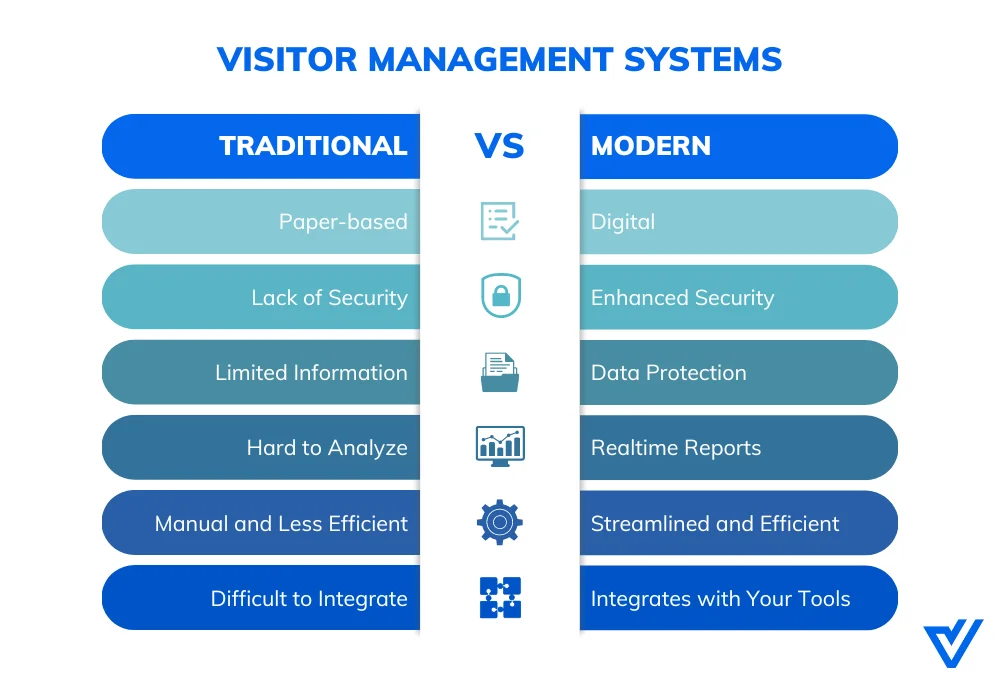
Jul 16, 2024
As the world increasingly goes digital and businesses adopt hybrid and remote workforces due to the pandemic, visitor management systems have become more than just a registration tool. This article explores the best practices for adapting visitor management systems into hybrid and remote work.
Written by Sam - Written: August 22, 2023

In a world that’s increasingly going digital, workspaces are no longer confined within four walls. As the pandemic pushed us to redefine ’normal’, businesses across the globe have enthusiastically embraced the hybrid and remote workforce model.
One significant paradigm in this shift is the visitor management system (VMS) that has gone beyond simple check-ins and check-outs. But the road to transformation is not without its bumps.
This article delves into the core of the latest technologies, tools, and best practices to ensure seamless integration of visitor management systems into the hybrid and remote work environment.
A remote workforce operates entirely outside a traditional office environment. These employees can work from anywhere—be it their home, a coffee shop, or across the globe. This model offers considerable flexibility, leading to improved work-life balance and often, higher productivity. Crucially, businesses need to adapt systems, like visitor management, to effectively cater to this new way of working.
On another note, a research shows that 83% of workers prefer a hybrid work model, highlighting the popularity of this method. A hybrid workforce is a type of work model that combines traditional in-office work and remote work. One of the primary benefits of the hybrid model is that it gives employees a sense of autonomy and control over their work environment and schedule.
For instance, a graphic designer in an advertising agency might opt to work remotely on certain days to focus on creating designs without the typical office distractions. They could then come into the office on other days for team meetings and collaborative brainstorming sessions.

The digital era has brought a sea change to the business landscape, shaping how organizations operate. Amid this transition, visitor management systems have evolved from being mere paper log books to become comprehensive management solutions, aiding the functionality of modern workforces. With a global shift towards remote and hybrid work models, these systems have had to adapt and take on new, crucial roles.
The utilization of electronic filing software has proven to be the first step of the evolution from traditional paper-based visitor management to digital visitor management systems. Integrating digital filing within a VMS offers efficient visitor management and data storage, allowing organizations to save space, reduce clutter, and preserve visitor records for longer.
Also, digital document management within a VMS ensures security and compliance. With advanced encryption and user-specific access controls, digital filing softwares can help safeguard sensitive visitor data, a paramount concern in today’s cyber-threat landscape.
That said, modern visitor management systems are now designed to maintain security, streamline communication, save time, and improve the overall efficiency by integrating with multiple digital tools.
Let’s dive into some of the best features that modern VMS offer.
Digital Check-In Systems: Transition from traditional logbooks to digital systems. For instance, visitors can enter their details into a tablet or kiosk upon arrival at the on-site workplace. This method not only enhances the check-in process but also bolsters data accuracy and security.
Pre-Registration of Visitors: This could be executed through an online portal where visitors provide their details ahead of their arrival, thereby speeding up the check-in process. Pre-registration also facilitates preparation for the visitor by the business, ensuring their meetings and workspace are adequately arranged.
Visitor Badges: Introducing an automated system to generate visitor badges immediately after check-in. This aids in identifying and tracking visitors on-site, thereby enhancing security and adherence to access control protocols.
Notifications: Automate notifications to alert staff when their visitors arrive. This can be done via email or text messages, minimizing wait times and improving visitor experience.
Health and Safety Protocols: In the ongoing hybrid and post-pandemic work context, incorporate health and safety checks into your VMS, such as symptom questionnaires, prioritizing the safety of both visitors and employees.
Visitor Analytics: Leverage the data collected to examine visitor trends and patterns. Insights derived can guide you in planning events, managing peak visitor times, and strengthening security measures.
Integration with Digital Tools: A digital visitor registration system can be seamlessly incorporated with other software in your organization. For instance, by exploiting no code automation tools you can utilize the data gathered within the VMS, assisting you in the creation of tailored reports, dashboards, and analytical tools.
Such integration provides project managers with valuable insights, enabling them to make informed decisions, identify bottlenecks, and optimize project performance.

In hybrid work settings, the visitor management systems are of use to different types of visitors.
Although remote employees primarily work from afar, they might make occasional in-office visits. An efficient visitor management system can accommodate these visits, ensuring these employees can seamlessly transition from remote to in-person interactions. This might involve implementing a streamlined check-in process, easy access to necessary resources, and a suitable workspace to carry out their duties.
Third-party visitors, such as clients, vendors, or contractors, require careful management. By adding a QR code feature, the check-in process for these visitors can be expedited and simplified. They can scan the QR code, input necessary information, and get directed to their point of contact within the organization. The best part? This feature is included within digital visitor management solutions.
This system can even be programmed to send notifications about their arrival to the relevant staff, ensuring that these visitors are received promptly and professionally. This enables smooth communication and ensures an exceptional experience for these visitors.
Implementing a visitor management system for a hybrid workforce brings several legal and security implications into consideration. One primary concern is the privacy associated with digital sign-ins. A VMS collects and stores personal information from visitors, which could include their name, contact details, company information, and even photographs.
Therefore, organizations need to be particularly cautious about how this data is managed. They must inform visitors about the data collection and its purpose and ensure the data is securely stored, not shared without consent, and deleted when no longer necessary, in line with data privacy regulations such as GDPR.
The issue of securing data from virtual visitors is another crucial aspect. Virtual visits, which have become more common in the hybrid work model, involve the exchange of information through digital channels. You need to ensure these digital interactions are secure and free from cyber threats. Robust encryption of data and secure conferencing tools are essential to maintain this security.
Finally, businesses must adhere to local and international regulations when implementing a VMS. This could involve laws related to data protection, health and safety, and anti-discrimination. Hence, it’s advisable to seek legal advice when designing and implementing a VMS to ensure full compliance.

For manufacturing plants that need to coordinate a variety of workers, contractors, and visitors, a VMS can be a game-changer. These facilities often deal with a high number of people entering and leaving their premises daily, increasing the need for effective visitor management.
Digital visitor management systems would enable manufacturing plants to track and monitor everyone entering the premises efficiently, thereby ensuring safety and security. Contractor and visitor details, including their contact information, purpose of visit, and duration, can be recorded digitally, reducing paper trail and administrative load.
Moreover, in case of emergency situations like fires or chemical leaks, a robust VMS would provide an accurate and instantaneous account of everyone on-site, which is critical for evacuation plans and emergency responses.
Further, an advanced visitor management system can be integrated with compliance requirements specific to the manufacturing industry. For example, visitors can be asked to digitally sign safety protocols or watch safety briefings upon check-in, ensuring they are aware of the site’s risks and their responsibilities.
The healthcare sector, particularly hospitals, can also significantly benefit from implementing a VMS. Given the sensitivity and confidentiality surrounding patient information and the need for stringent infection control, visitor management becomes crucial in a hospital setting.
A digital visitor registration solution could help hospitals efficiently monitor and control visitor flow, thereby reducing overcrowding and potential infection risks. Hospitals can implement measures like visitor pre-registration, scheduling visit times, limiting the number of visitors per patient, and creating zones where visitors are allowed.
Hospitals often have a variety of professionals visiting, including pharmaceutical representatives, equipment suppliers, contractors, and medical students. A VMS would provide a transparent record of these visitors, including their visiting purpose and visited departments, thus ensuring a higher level of security and accountability.
Besides, a VMS with a touchless check-in feature could minimize contact-based infection risks. It can also be customized to screen visitors for symptoms or vaccination status, aligning with the hospital’s infection control protocols.
In a hybrid and remote work setting, project management and balancing workload plays a critical role for marketing agencies. It provides structure, ensuring tasks are completed on time and team members are coordinated. That includes leveraging project management tools to organize employees’ tasks and keep track of progress.
In this context, the synergy between a visitor management solutions and project management tools is particularly valuable. For instance, let’s consider a scenario where a marketing agency is hosting a client for a project kick-off meeting. Project management tools can streamline agency workflow by assigning tasks like preparing the meeting agenda, gathering relevant data, setting up deadlines, and assigning a presenter. On the other hand, the VMS synced with the project management tool, can facilitate pre-registration of the client visit, thus informing the relevant team members of the scheduled meeting.
How To Grow a Digital Marketing Agency is an essential consideration for marketing agencies looking to expand their services and clientele. Post-meeting, any feedback or new requirements from the client can be updated in the project management tool in real-time. This not only ensures a systematic workflow but also keeps all team members on the same page, boosting productivity and enhancing project outcomes.

In this article, we’ve explored the significance of adapting visitor management solutions to the new work paradigm, delving into the features that make a VMS effective, and the importance of tailoring these systems to different types of visitors.
By leveraging the power of technology and innovative digital visitor management features, businesses can ensure a smooth transition, enhance operational efficiency, and maintain a secure, productive work environment. The future is flexible, and with an adaptable visitor management system, your business can be too.
Want to know if modern visitor management systems will benefit your company? Try out Vizito with a 14-day free trial. For more information, chat with us or book a demo!